Peep!
2013 송원아트센터 신진작가 지원展
2013 03.07 ~ 2013 04.05
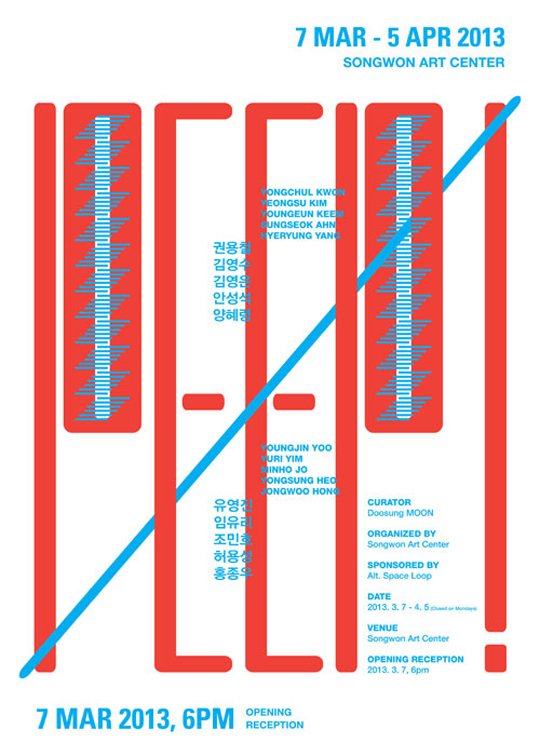
참여작가
주재환과 착한 작가들 Joo Jae Whan with good fellows
(주재환_박준식_손민아_이대일_정기현_허태원_홍원석)
뮌 Mioon_최성록 CHOI Sungrok_정지현 JUNG Jihyun
방 & 리 Bang & Lee_김준 KIM Joon
참여기관
경기창작센터_인천아트플랫폼_난지미술창작스튜디오
운영자 대담_작가와의 대화
2013_0601_토요일_02:00pm
2013_0601_토요일_04:00pm
주최 / 서울시립미술관_송원아트센터
주관 / 난지미술창작스튜디오
협찬 / 대안공간 루프
이 전시에 참여하는 모든 이들에게는 ‘젊은’, ‘신진’ 등의 수식어가 붙는다. 그러한 수식어들이 지닌 어떤 강렬한 덩어리는 시대를 불문하고 어느 분야에서든 이목을 끌어왔다. 가치가 드러나지 않거나 적게 드러난 것일수록 그것이 발견될 수 있는 가능성은 더 높다. 그렇기에 새롭고 신선한 것에 대한 기대는 그들이 가져올 ‘더 나은 무언가’를 바라보는 것에서 시작된다. 우리는 대개 불확실하고 막연한 기대를 두고 공허하다고 말한다. 그래서 시간이나 권위에 의해 검증되고 인정받은 대상과 동행하며 안위(安慰)를 얻기도 한다. 하지만 인류에게 역사라는 개념이 존재하는 한 그 행위들은 더 이상 공허하지 않다. 우리는 더 나은 미래를 만들어가기 위해 과거를 기억하며 현재를 직시한다. 그렇게 함으로서 다가올 시간에 대한 예상 시나리오를 꾸며줄 키워드들을 수집한다. 이 수많은 키워드들은 양이 너무 방대해 넘쳐흘러 무용해지는 부분도 생겨난다. 하지만 넘치도록 부어야 그릇은 어느 때보다도 가득 차오른다. 이러한 역사의 모습을 본다면, 새로운 것이 가져올 ‘더 나은 무언가’는 어떤 종착점이 아닌 것처럼 보인다. 그것은 지금도 계속 쓰여지고 있을 시나리오에 신선한 키워드를 제안하는 행위 그 자체일 것이다. 장담컨대, 새로운 것에 거는 기대는 비록 불확실한 것일지는 몰라도 적어도 막연한 것은 아닐 것이다. 이 전시 역시 그 행위 안에 포함될 수많은 시도들 중의 하나가 되기 위해 기획되었다. 또한 드러난 부분보다 드러나지 않은 부분이 더 많은 젊은 작가들의 작업으로 공간과 이야기를 구성하였으며, 이를 통한 새로운 예술 트렌드 포착을 가장 앞에 두었다. Peep!에 참여하는 20-30대의 젊은 작가 10인은 이전 세대들이 종종 언급하는 ‘좋은 시대’에 태어나고 성장한 작가들이다. 20세기 동•서양간의 문화 불균형에서 벗어난 풍요로운 시대를 살며 누구보다도 독립적인 가치관을 형성한 이 세대는 그만큼 어떠한 이데올로기나 제도를 마주함에 있어 자유롭다. 이들에게 있어 서구의 문화는 예전처럼 무작정 따라가야 할 ‘좋은 것’이 아니다. 자본이 문화를 조성하고, 경제적 강자가 그 흐름을 주도하던 시대에 관한 이야기 역시 그저 들어서 알고 있을 뿐이다. 이들은 오직 스스로가 제시하는 기준에 따라 외부환경을 해석하여 다양하게 노출시킨다. 앞서 말한 그들의 자유로움은 대상이 지닌 경계로부터의 회피나 탈출의 의미가 아니다. 대상을 독립적인 주체성이라는 기준으로 파악하고 그 본질을 각자가 제시한다는 의미이다.
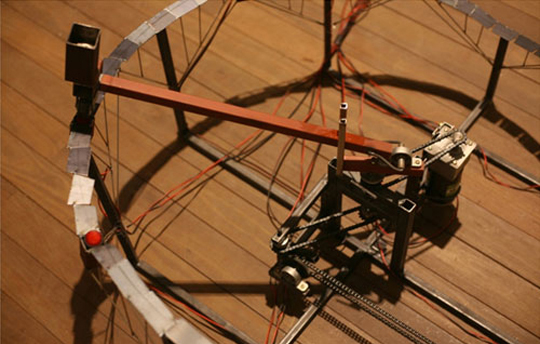
권용철_The Movement Series-Study Switch_스틸, 모터, 기어, 체인_50×120×120cm_2012
권용철은 서로 연계된 금속 장치들을 이용하여 개인 간의 관계성에 대해 이야기한다. 하나의 장치가 움직이기 시작하면 어떤 특정한 시점에서 다른 장치에게 신호를 보내게 되고, 그 신호에 의해 다른 장치가 움직이거나 소리를 낸다. 앞에 선 관객은 장치들이 보여주는 각각의 모습에 자연스럽게 집중하게 된다. 그리고 전체의 움직임을 감상하며 단순한 유희를 느낄 수도 있다. 하지만 가장 유심히 보아야 할 것은—그러한 자연스러운 집중이나 단순한 유희 때문에 놓치게 되는—그들이 서로 영향을 주고받는 방식이다. 우리는 살아가면서 맺는 수많은 관계들을 과연 얼마나 놓치지 않고 인식할 수 있을까?
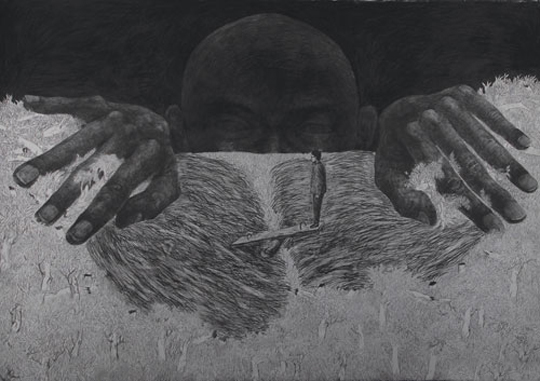
김영수_For a 4-Person Family_종이에 연필_100×240cm_2011
김영수는 자기 주변의 현실과 사건들을 마주함에 있어 객관적 시선을 차치(且置)하려 한다. 자신의 주관은 물론, 현실을 이루는 타인의 주관에 집중하여 그들이 지니는 감정선에 우선적으로 접근하려는 것이다. 작가는 현실이나 사건의 모든 구성원들에게 집중하며 각자의 주관들을 수집하여 재구성한다. 거기에 마지막으로 그의 주관이 더해져 내러티브가 생성되고 실재를 향한 새로운 요청이 시도된다. 그러한 방법으로 작가는 현실에서 자신이 처한 위치를 가늠하고자 한다. 또한 감상자가 그의 세계로 들어와 하나의 주체가 되어, 현실과 사건에 동참하며 서로의 감정을 공유하고 치유하길 바라는 것처럼 보인다.
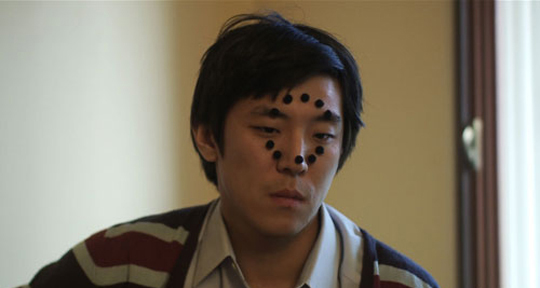
김영은_The Units of the World According to ; Semicolon_단채널 비디오_00:25:48_2011
김영은은 세미콜론; 이 본 세계의 단위들 에서 소리와 기호의 언약으로 이루어진 언어 개념을 이야기한다. 이 이야기 속에는 콜론, 하이픈, 말 줄임표, 괄호, 따옴표 같은, 명칭이나 형태를 가진 문장 부호들이 등장한다. 우리는 텍스트를 읽으면서 문장부호에 어떠한 음성도 부여하지 않는다. 하지만 그 부호들은 각자의 의미와 성격을 가진다. 영상 안에서 이 부호들은 자신들의 음성을 갖고 스스로 표현하기까지 한다. 이 음성들이 문장부호의 성격과 부합하는 것인지는 중요하지 않다. 문장부호는 그 형태가 고정되어 있지만, 포함된 문맥에 따라 그 의미가 자유로워지기 때문이다.
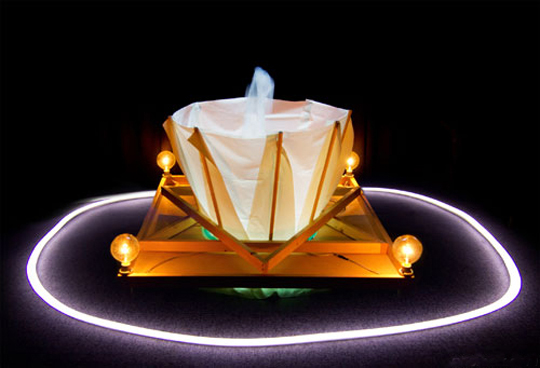
안성석_Spouting and Children Get Wet with the Water while Adults are Looking at Them All Day_
혼합재료_150×150×150cm_2012
안성석의 작업 안에서는 과거와 현재가 뒤섞여 흐른다. 우리는 역사를 이야기 할 때 과거를 가져와 해석하며 정의한다. 하지만 여기에서 이루어지는 해석이라는 행위는 어디까지나 지금이라는 기준을 중심으로 이루어진다. 지금도 광화문 앞에는 조선시대 복장을 한 서울시청 소속 직원들이 창이나 깃대를 들고 서있다. 14세기 말 태조 휘하에서 일하던 군인들도 같은 모습으로 서 있었을 것이다. 어쩌면 현재가 말하는 과거란 현재가 스스로를 존재시키기 위해 구성해내는 것일지도 모른다. 그래서 그는 광화문이라는 역사적 아이콘을 갤러리 안으로 가져다 놓았다. 현판도 있고, 분수대도 있으며 심지어는 현장의 소리까지 난다. 진짜 광화문이다.
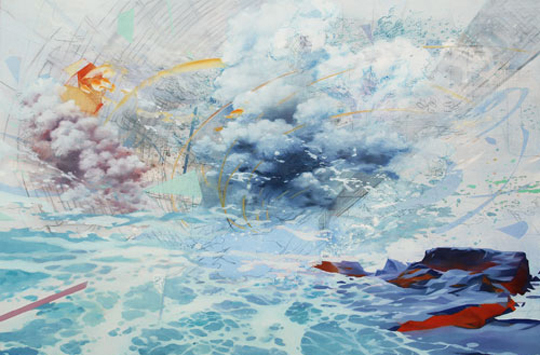
양혜령_On the Journey_캔버스에 색연필, 유채_80×116.8cm_2011
양혜령은 경험에서 얻은 인상의 파편을 저장한다. 그리고 그 파편을 다시 꺼내어 재구성한다. 이성과 감성에 의해 해석되어 소중하게 보관된 감각의 조각들은 언젠가 다시 기억된다. 작가는 그러한 것들을 하나의 평면 위에 기하학적으로 배치한다. 이로써 실재를 소재로 하지만, 실재하지 않는 아이러니한 공간이 생겨난다. 이렇게 뒤집힌 공간을 제시함과 동시에 그 감각의 파편들과 직접적인 관련이 있는 물질성을 지닌 파편들을 병치시킨다. 그러면 공간은 다시 한번 더 뒤집힌다. 이 순간 이 공간은 실재와 허상의 사이에서 부유하게 되며, 관객은 그림 앞에 놓인 작은 파편들과 함께 그 안으로 유입된다.
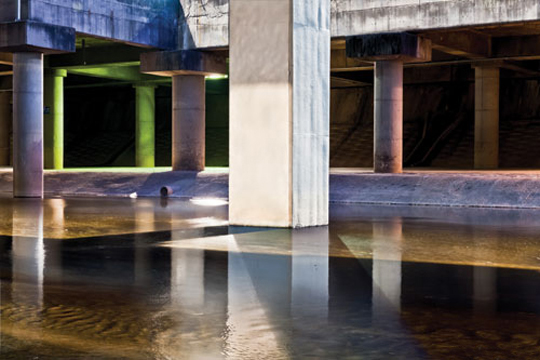
유영진_nowhere_잉크젯 프린트_70×100cm_2012
유영진의 사진 작업은 사적인 장소를 탐색하려는 시도이다. 우리에게 주어진 공간은 누구의 것도 아니다. 나만의 장소를 가지기 위해 세상 어느 곳을 뒤져보아도 그곳은 누군가와 공유되고 있거나 공유하게 될 곳이다. 작가는 고정시킨 카메라를 이용하여 특정한 장소를 시간대별로 촬영한다. 그리고 이 여러 장의 기록물들을 겹쳐서 하나의 회화적 분위기의 장면을 연출한다. 사진은 현실을 그대로 담아내는 매체이다. 하지만 여기서는 디지털 합성이라는 기법을 통과하여, 실재하는 장소에 비현실성을 부여하는 재료가 되었다. 작가는 이러한 방식으로 실재하는 공적인 장소를 자신만의 사적 영역으로 끌어들였다.
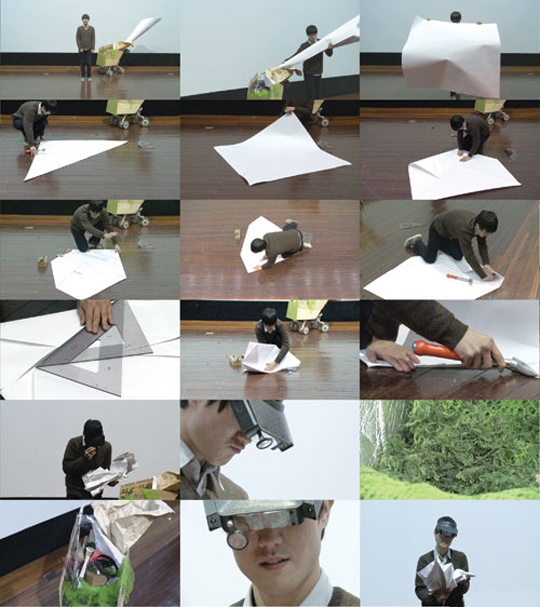
임유리_Origami Q_HD 비디오_00:21:08_2011
임유리는 자신의 사소한 경험의 단편들로부터 작업의 소재를 이끌어낸다. Origami Q는 가상의 인물이 종이 접는 방법을 설명하다가 그 대상에 심취해 가는 장면을 보여준다. 종이 접기의 결과물은 마치 세상의 모든 것을 다 담을 듯 다양하다. 하지만 그 모습에 부여되는 의미는 다소 억지스럽다. 우리가 살면서 시각화 된 기표들에게 어떠한 의미를 부여하는 행위는 어쩌면 이렇듯 억지스럽게 심취해가는 과정이 아닐까 한다. 다른 작업 그리운 금강산은 작가가 유학시절 겪었던 타지의 생경함에서 비롯되었다. 작가는 독일의 한 도시의 탑 위에 있는 종이 15분 간격을 두고 엄청나게 큰 소리로 울리는 것에 공포를 느꼈다. 그러나 현지인들은 너무나도 익숙하여 그저 흘러 넘길 뿐이었다. 그래서 한국의 가곡을 종소리에 맞춰 그들에게 들려주기로 했다. 현지인들에게 이 낯선 노래는 아마 그 큰 종소리보다 더 크게 들렸을 것이다.
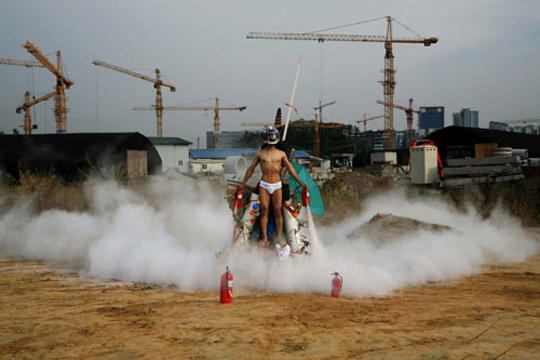
조민호_The man with his blossom_단채널 비디오_00:08:37_2008
조민호는 Specter Project 라는 주제 아래 2008년 숭례문 방화사건을 다루는 작업을 해 왔다. 사건 직후부터 현재까지 숭례문 일대를 관찰하며 기록한 영상이나 사진 작업을 통해 사건의 단면과 내막, 현상과 본질, 역사성과 현장성에 대한 논점들을 제시한다. 출품작 꽃을 멘 남자 는 이 프로젝트의 일환으로써 숭례문 방화범과 물질적 욕망에 관한 이야기를 담고 있다. 작가는 직접 자전거를 타고 고양 시내를 달린다. 이곳은 재개발 공사로 인해 민과 관의 갈등이 심화된 곳이기도 하며, 그로 인해 방화범이 범행을 계획하게 된 근원지이다. 그리고 마지막으로 화환 로켓을 타고 반복되는 현실에서 탈주하고자 하나 곧 추락하여 원점으로 되돌아오고야 만다. 이 추락은 숭례문 방화범을 비롯하여, 자본과 인간 사이의 괴리감으로 인해 소외되고 도태되는 개체를 표현한 것처럼 보인다. 숭례문의 복원 완공을 코앞에 둔 지금, 이 대단한 프로젝트는 앞으로 어떤 재치 넘치는 명제를 더 제시할 수 있을까.
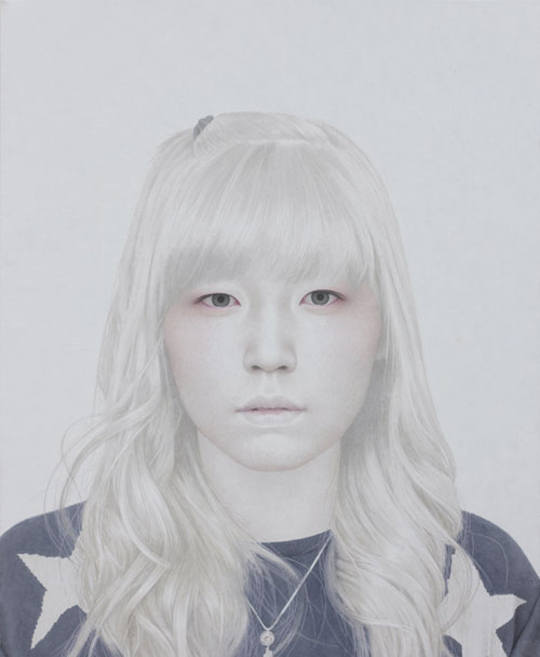
허용성_White woman_한지에 먹_100×80.5cm_2011
허용성이 그려낸 초상은 마치 내면의 모든 것을 그대로 드러내려는 듯 순백의 얼굴로 관객을 응시한다. 이 앞에 선 감상자에게는 테크네적 압도에 이어 공허와 불안이 찾아온다. 젊은 얼굴들은 그 수식어가 무색하게도 극도로 정적이다. 젊은 혈기(血氣)같은 것은 없다. 기성세대의 사회조직 울타리 밖으로 밀려난 이들은 아무리 진실을 말하려 하지만 누구에게도 전달되지 않는다. 공허한 외침이 되어 허망하게 사라지거나 왜곡되어 변질될 뿐이다. 이 젊은 초상들은 진실이 통하지 않는 세상을 인정하며 체념한 듯 마냥 하얗기만 하다.
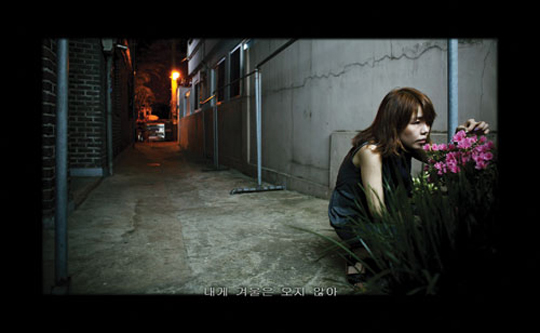
홍종우_Uncut-jisu_라이트 박스에 프린트_80×130cm_2012
홍종우의 사진은 영화의 한 장면을 떠올리게 한다. Uncut Version, 영화를 제작함에 있어 어떤 규제나 선택 때문에 삭제되거나 변경되는 부분 없이 제작되는 버전을 말한다. 작가는 각 인물들 개개인이 자신의 삶에서 드러내고 싶지 않은 부분들을 직접 인터뷰하여 가져온다. 그리고 이 이야기들을 영화의 한 장면을 캡쳐해 내듯 표현해낸다. 그리고 작품으로서 실재하게 한다. 그 순간 그들의 인생은 편집되지 않은 무삭제판이 되면서 그 경계와 범위가 확장되며 삶에 더 많은 이야기를 담을 수 있게 되는 것이다. 여기에 나열된 주체들이 제시하는 새로운 트렌드란 과연 무엇일까. 일본의 작가들이 망가(manga)나 아니메(anime)같은 대중문화를 소재로 삼으면서 외로움과 음울함을 드러내고, 중국의 작가들이 급격한 도시화와 산업화에서 오는 혼란과 인간에 대해 이야기한다면, 위 작가들은 자신만의 경험과 감수성으로 구축한 세계를 보여주며 ‘주체적 자기 예술’을 새로운 트렌드로 제시하는 것이 아닐까 한다. 이들이 가진 이야기들은 모두 각기 다른 내용과 형식을 담는다. 하지만 자신의 실존을 작업으로써 증명하고, 그것을 토대로 세계를 해석하며 미래를 향한 키워드를 끊임없이 던진다는 공통점을 가진다. 외부의 영향에 구애 받지 않은 유연함은 주체의 무한한 확장을 돕는다. 이 전시장은 ‘더 나은 무언가’를 향한 키워드로 가득 차 있다. ■ 문두성
“Young” and “emerging” are the common adjectives usually attributed to the artists who participate in this exhibition. Regardless of the context of their attribution, such as field or period, these adjectives have been always successful in attracting large attention. The less exposed its value has been, the more left latent to be exhumed; it is the rule of attraction where the power of those adjectives reside. Anticipation for the new and fresh, thus, is promoted by the desire to seek “something more valuable” or “something better” that the undiscovered can bring about. Uncertain and vague expectation is pointless, we often say. This would be one of the reasons why we look for comfort by dwelling around the objects, which have become already well known over the duration of history and fairly approved by reliable authority. In so far as we reflect on the concept of history, however, those expectations are no longer in vain. We remember the past and try to see through the present in order to build a better future. To this end, we collect numerous keywords from the past experiences, which will serve to the estimated scenarios foreseeing the moment to come. Sometimes these keywords are so many that they become superfluous for our purpose of accurate forecast. Nevertheless, a vessel will be full more than ever only when water seems to be overflowing. Such image of historical process indicates that “something better” expected from the new is not a fixed destination of any sort. Rather an activity itself it will be, by which the novel keywords are added continuously to the scenarios that have been in process of being written. Expectation towards the new and fresh may contain insecurity, but, at least, it is certainly not empty or useless. The objective of this exhibition is just the same, hoping to be part of the on-going activity of endlessly writing, editing, and rewriting one of those scenarios. In the forefront of the curatorship lies a possible prehension of emerging artistic trend through the constellation of young artists, whose works have more facets to discover than those have already been uncovered. Now in their twenties or thirties, the ten young participants in Peep! wereborn and grew up over the period that has often been dubbed as “better days” by previous generations. Living on easy street in the late twentieth century when the cultural discrepancy between the East and the West had been reduced, the generation of these artists formed an independent set of cultural values. As a result, they tend to be hardly cowed in confronting an existing ideology or institution. For them the so-called Western culture is no longer equal to “good stuffs,” which the rest of the globe has to follow without question as before. It would make merely a tale of once-upon-a-time to them that the one with economic power controls the creation of culture by capital. These artists dissect and expose the environment of existence in diverse ways by interpreting it exclusively from their own individual perspectives and measures. Such freedom from the established authorities, however, cannot be misunderstood as an easy escape from given limitations or an evasion of critical responsibility over the subject matters. It refers to the independent subjectivity of each artist, which functions as the sole barometer in grasping the objects and representing their nature.Yongchul KWON addresses the relationship between individuals through instruments made of metal, which are connected to one another. As soon as one starts moving, it transfers a signal to another; triggered by this signal, the one tuned to it initiates a movement or makes noise. In front of them, the viewer naturally becomes to concentrate on the variegated appearance and actions that every device presents. Or, looking over the overall movement, the viewer could enjoy rather simple pleasure. Nonetheless, the most prominent aspect of this mechanical organism would be the way in which they give and take influence to each other, which is easy to overlook due to the natural attention to bustling parts or the simple appreciation of bigger spectacle. How meticulously can we recognize the countless relationships that we have come across in lifetime without omitting them? Yeongsu KIM tries to extinguish objective perspectives from his encounters with reality and objects in ordinary surroundings. The main purpose of this endeavor is to get in touch with the emotional lines first, by focusing on the subjectivity of each individual. In fact, it is the network of these emotional lines maintained by people, including the artist himself and the others, what constitutes the fabric of the reality. Through an intense observation of every agent who has been involved into an event in reality, the artist collects subjectivities and reconstructs them. When this collection of subjectivities meets the artist’s own subjectivity, a narrative is about to be generated and attempts to become the new reality. Such method allows the artist to locate himself in the reality. He seems to invite the viewer to his empire of subjectivities, encourage him or her to become another subject inhabiting the realm, and share and heal each other’s emotions by participating in events in the reality. Youngeun KEEM introduces in her work The Units of the World According to ;Semicolon a concept of language that consists of the verbal contracts between sounds and signs. In this description appear punctuation marks that already have name and shape, such as colon, hyphen, ellipsis, parenthesis, and quotation mark. It is normal, however, that no phonetic value is added to these punctuation marks during the course of the recitation of texts. Nevertheless, it is also true that each of these marks possesses the authentic meaning and characteristic of its own. On the screen of KEEM’s work, these marks not only have distinctive phonetic values but also express meanings by themselves. It would be relatively insignificant to ask whether the sounds accompanying the punctuation marks accord with their characteristics, since their meanings, unlike their shapes, are free from any fixation depending on the context of their inclusions. Sungseok AHN turns his work into a point of confluence where the past and the present become indistinguishable. When it goes to history, we tend to capture, interpret, and define the past. In this activity of historical interpretation, however,the reference point is firmly anchored into the present. Workers hired by the City of Seoul are still standing in front of the Gwanghwamun attired in the army uniform of Joseon. The same appearance would be shared by the soldiers of Taejoin the late fourteenth century. Here we realize that the past dubbed by the contemporary interpretation can be a construct essential for sustaining the present. The artist, therefore, took and moved the historic monument Gwanghwamun into the gallery. There are the signboard, the fountain, and even the sound of street; indeed the real Gwanghwamun it is. Hyeryung YANG hoards the fragmented impressions captured from her lived experience. She then opens up her storage, takes everything out, and reconstructs them. The fragments of emotions interpreted and cherished by rationality and sensibility are meant to be recollected someday. In result, a peculiar type of space is created, which is made of the reality as its material but doesn’t exist in reality. In tandem with the presentation of such upside down space, the artist juxtaposes the fragments of sensation and the material debris that directly linked to the formers. Inverted once again becomes the already topsy-turvy space. At this moment, the space starts floating in its own mutated topology of the real and the fictive; the viewer is tumbling down into the rabbit hole through the constellation of debris aligned in front of the painting. Youngjin YOO makes efforts to navigate private spaces in his photography. Different spaces in this world no way come into the possession of a single individual. Any attempt to find the place solely occupied by oneself will be futile, since he or she will end up learning the fact that every space is being shared or will be shared with somebody else. The artist photographs a specific place repeatedly at afixed interval. Overlapping each other on one plane, these consecutive images produce a scenery with painterly mood. Photography at first is a medium that documents the reality without distortion. By the aid of the technique of digital synthesis, however, it becomes a tactic to impose surreal qualities onto the real spaces. In this way the public space gets absorbed into the artist’s private realm. Yuri YIM draws the material of work from humble experiences of her own. Origami Q shows a scene in which a fictional character explains how to make origami and suddenly gets attached to the object of his explanation. The outcomes of origami are so various and many that they could replace the entire creature in this universe. Ridiculous and unconvincing, however, are the meanings invested into each shapes of origami. Isn’t it such blind infatuation what drives human beings to invest meanings into the visualized signifiers? Another work by the artist A Longing for Geumgang Mountin is derived from her experience of being an alien livingfar away from home. Studying abroad in a city in Germany, she got scared by the deafening sound of the bell up in a tower, which kept ringingregularly at aninterval of 15 minutes. The local residents, on the other hand, hardly recognized the overwhelming decibel of the bell. Against this prevailing ignorance caused by the comfort of getting used to something, the artist played Korean song “A Longing for Geumgang Mountin” every time when the bell rang. To the local residents, this unfamiliar Korean song might be much louder than the bell in a tower. Minho JO has been dealing with the tragic fire of Sungnyemun (Namdaemun) in 2008 under the theme of Specter Project. In this project, he raises issues around the event, such as a cross section by media and insider stories, a phenomenon and its nature,and historicity and realism, through the videos and photographs of the neighborhood of Sungnyemun that he documented since the incident until now. Featured in this show, The man with his blossom is part of Specter Project, embodying the story of the Sungnyemun arsonist and the material desire. The artist rides a bike across the downtown of Goyang, the place of origin where the arsonist decided and planned to set the fire. His decision on incendiarism reflects Goyang’s inner conflict between the city and the habitants that has deepened due to the redevelopment. In a subsequent scene, the artist tries to escape from the repetitious reality by getting on a rocket made of flowers, but before long the rocket plunges down to the earth and back to the real. This crash could be interpreted as the portrayal of an individual, the Sungnyemun arsonist, for example, who has been forced to be alienated and dismissed by the disjunction between man and capital. At this point when the completion of Sungnyemun restoration is just around the corner, how clever and shrewd comments on our society the artist’s Specter Project could continue to produce? Yongsung HEO executes portraits that stare at the viewer as though they long to reveal everything about them without hiding. The anxiety about emptiness and meaninglessness follows an overwhelming pleasure offered by the artist’s aesthetic craftsmanship. The extremely static atmosphere of the portraits casts young physiognomies depicted in the pictures into the shade. No youthful vitality the figures display. Ostracized from the societal structure preoccupied by the established generations, these young things lack voice so as to fail to communicate or to be heard, no matter how hard and loud they shout out the truth. Their voices, just like their appearance visualized in the artist’s work, disappear into nothing at best, or to be distorted and abused at worst. White and pale as paper the portraits of youths are, as they have already admitted the impossibility to communicate the truth and succumbed to the reality. Jongwoo HONG he’s photographs remind the viewer of specific scenes from movies. Uncut version refers to the specially made edition of film, which contains the whole length of playing time relying on the director’s aesthetic decision exclusively, without editing or cutting outparts being forced by external regulations or limitations. By interviewing people on a person-to-person basis, the artist brings into the film all the coy secrets that nobody wants to disclose to others. These stories are expressed in the visual as they are the snapshots of different movies, which are about to exist as a real movie in the form of the artist’s film. At this moment, the life tales included in the artwork are transformed into “uncut versions”that remain intact yet extend their boundaries and contours over the viewer’s life in order to makelife more crowded with stories. Which keyword can summarize the best a new artistic trend that these subjects introduced here represent? While Japanese artists express loneliness and grotesqueness by appropriating themes of popular culture, for instance, manga or anime; Chinese artists speak for confusion and humanness erased from the context of rapid urbanization and industrialization; these young artists of Koreacome together under the pursuit of “independent subjective art,” luring the viewer into their worlds built with individual experiences and subjectivities. Each story these artists employ pertains to the disparate content and form. However, they share the tendency to testify their own existence in this world through their works, to utilize them as the tool to interpret the reality, and to pose keywords to the future restlessly. Resilience of a being who is free from external influences works for the infinite extension. This exhibition is full of keywords that point towards “something better.” ■ Doosung MOON


Leave a Reply